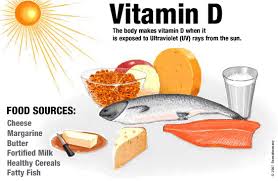fat soluble vitamin
-vitamin d
Vitamin D can be synthesized in the body in adequate amounts by simple exposure to sunlight, even for 5 minutes per day is sufficient.It is essential for bone growth and calcium metabolism.
It acts as a hormone in the body by facilitating calcium absorption and deposition in the boneFunctions.
1. Vitamin D helps in the absorption of calcium and phosphorous by increasing the synthesis of calcium binding protein.
2. Vitamin D helps to maintain the calcium and phosphorous levels in the body by stimulating,
a) Absorption in the gastro intestinal tract.
b) Retention by the kidney
3. Vitamin D helps in deposition of calcium in the bones. The bones grow denser and stronger.
Sources
The Vitamin D content of food sources from animals varies with the diet, breed and exposure to sunlight of the animal. The good sources of Vitamin D are cod liver oil, shrimp, liver, butter, yolk, cheese, milk, spinach and cabbage.

Requirements
The expert group of ICMR has not recommended dietary intake of Vitamin D for Indians.
Only in those cases where the Vitamin D requirement is not met due to inadequate exposure to sunlight the ICMR recommends 400 μg/day of VitaminD .
Effects of Deficiency
Deficiency
Deficiency of Vitamin D leads to decreased absorption of calcium which is manifested as muscular tetany, rickets in children and osteomalacia in adults. Due to faulty calcification of bones the following derfomities is manifested in children which is called rickets. It
is a disease in which there is weakness and abnormalities in bone formation. Rickets primarily affects children.
Vitamin D deficient child-Rickets
Manifestations:
a) faulty deposition of calcium on the bones.
b) Bowing of legs
c) Enlargement of ends of long bones
d) Deformities of ribs – beading of ribs
e) Delayed closing of frontanel
f) Slow erruption of teeth.
g) Malformed, decay – prone teeth
Osteomalacia in Adults
Osteomalacia is a condition where the quality of the bone is reduced. It occurs in women who are not exposed to sunshine and who have depleted mineral reserves resulting from successive pregnancies and prolonged lactation. Osteomalacia is associated with low phosphorous level but low blood calcium level is the most frequent cause.
The following symptoms occur
1. softening of the bones
2. deformities of the limbs, spine, thorax and pelvis
3. demineralization of the bones
4. pain in pelvis, lower back and legs
5. frequent bone fractures.